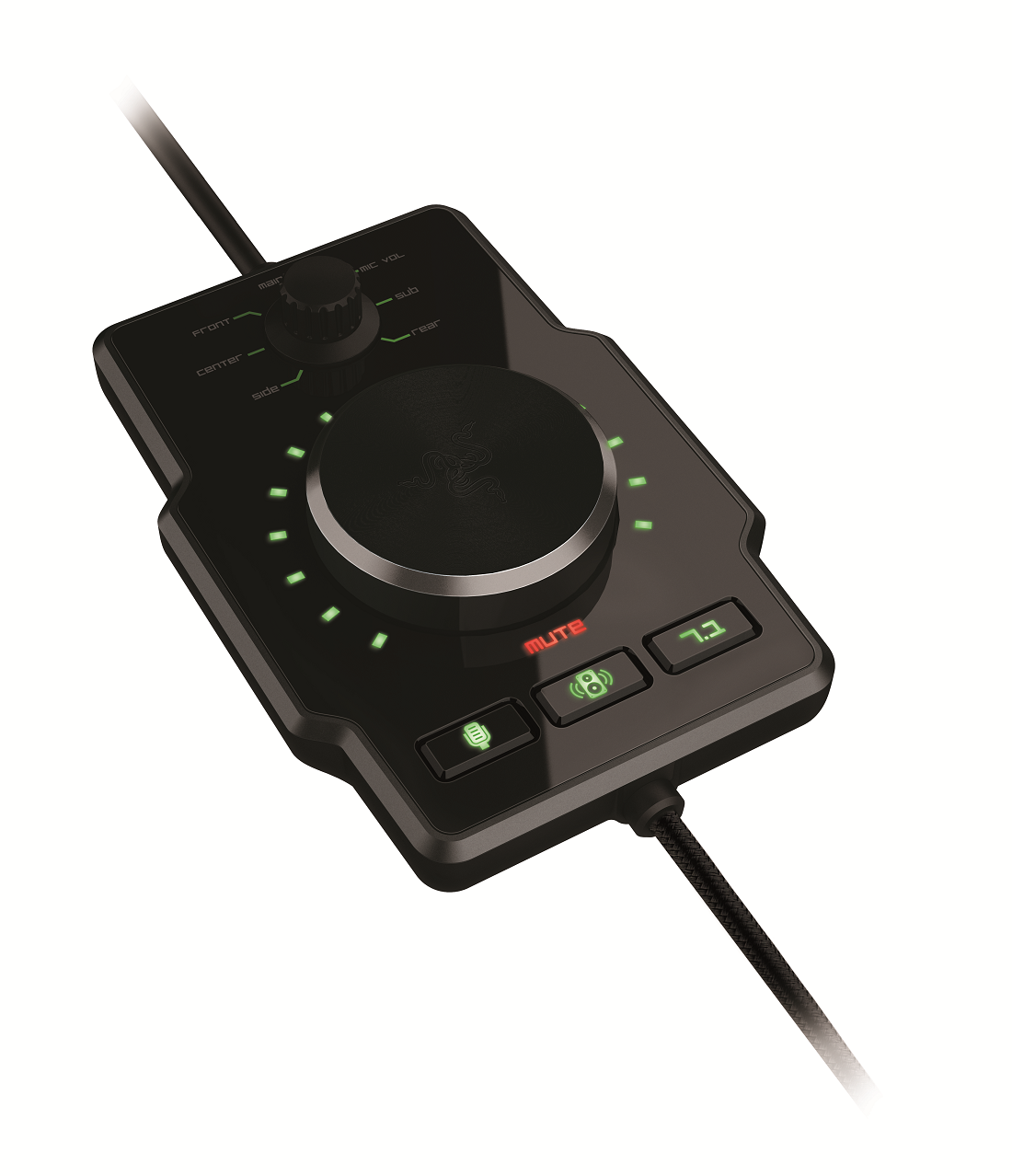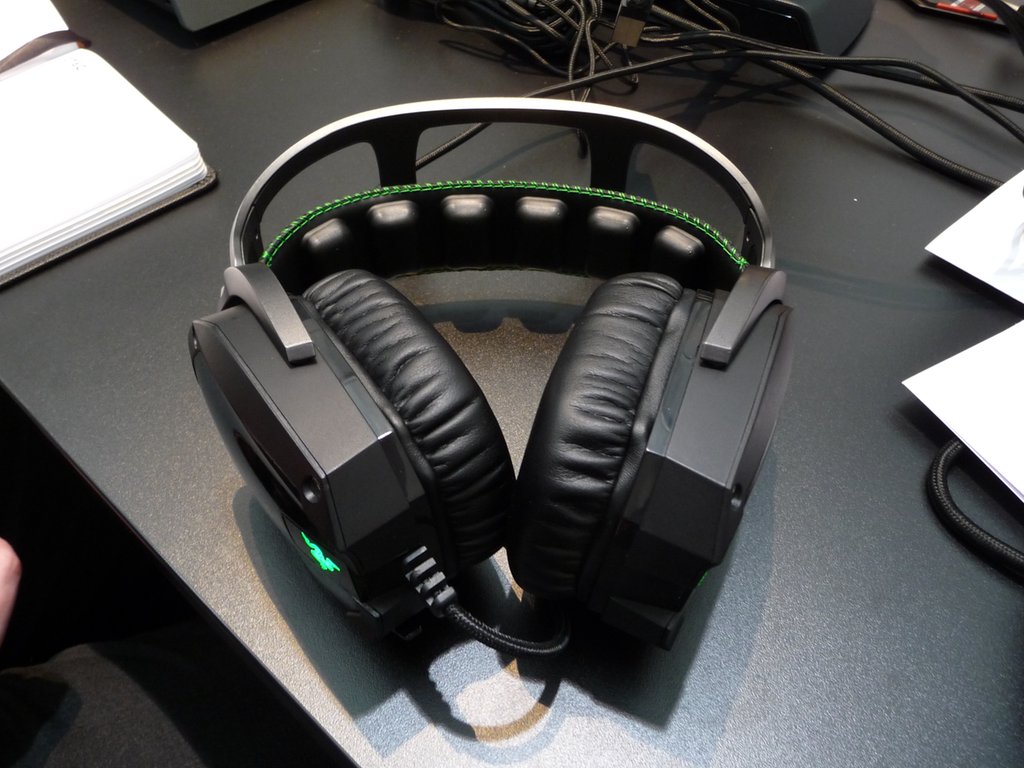 Razer made some serious waves with its virtual surround sound Megalodon 7.1 headset. Most gamers, however, were wondering when they would release a true 7.1 channel design. The wait is over as Razer has released its Tiamat 7.1 channel “elite” gaming headset. Featuring a total of 10 sound drivers, the Tiamat 7.1 is a technological marvel of headset design, featuring a hearty black plastic design with a very dense braided cable. Unlike the Psyko Carbon 5.1 gaming headset which, while providing excellent audio quality, is very heavy and uncomfortable after long periods of use, the Tiamat 7.1 features more drivers and is less weighty by quite a bit. The Tiamat 7.1 also features soft, leatherette ear cups which allow for the unit to be worn for long gaming sessions with little discomfort.
Razer made some serious waves with its virtual surround sound Megalodon 7.1 headset. Most gamers, however, were wondering when they would release a true 7.1 channel design. The wait is over as Razer has released its Tiamat 7.1 channel “elite” gaming headset. Featuring a total of 10 sound drivers, the Tiamat 7.1 is a technological marvel of headset design, featuring a hearty black plastic design with a very dense braided cable. Unlike the Psyko Carbon 5.1 gaming headset which, while providing excellent audio quality, is very heavy and uncomfortable after long periods of use, the Tiamat 7.1 features more drivers and is less weighty by quite a bit. The Tiamat 7.1 also features soft, leatherette ear cups which allow for the unit to be worn for long gaming sessions with little discomfort.
Setting up the Tiamat 7.1 is simple – plug in the five 3.5mm audio jacks to the various outputs on the back of your PC/sound card, and insert the USB cable into an available USB 2.0 port. While the audio comes in through the audio jacks, Razer chose to power the unit via USB. The Tiamat 7.1 is an analog headset, meaning you need to have actual audio outputs for each channel on the sound card you use. If your sound card only supports 5.1 or 2.1 sound, you will not be able to utilize the Tiamat 7.1’s full range of sound channels. Adjusting the Tiamat 7.1’s volume and equalization is done through the included control unit. The control unit features a volume knob of considerable diameter, meaning you have a lot of minute control in just how much volume you want to pump into your ears. Furthermore, you can select individual channels as well as adjust the EQ settings right from the control unit. For those wishing to chat with team mates or friends, the Tiamat 7.1 has a retractable boom microphone which works very well and, as my team mates have reported, captures clear voice chat.
Using the Tiamat 7.1 is a pleasure. I had no issues with the unit whatsoever and did not encounter a “bass bug” which some reviewers are reporting. Razer has mentioned the fix for this issue in the product’s official FAQ. It is actually an issue with the Windows default sound driver, not the headset. I have been fortunate to use the Tiamat 7.1 in multiple gaming environments – from the mechanized combat of Wargaming.net’s World of Tanks to the zombie-killing goodness of Valve’s Left 4 Dead 2. While many games I played did not take full advantage of the Tiamat’s 7.1 channels, several did. Each of those that did proved to be illuminating experiences, and the positional audio coming through the headset’s earcups added an entirely new element to my gaming. It was actually off-putting to go back to lesser numbers of channels in my gaming afterwards. My hope is that this spurs developers to take more advantage of 7.1 channel audio in their game development. Time will tell…
Razer’s Tiamat 7.1 elite gaming headset represents a new generation of PC gaming audio. Sure, we have seen 7.1 desktop sound systems before, but never a TRUE 7.1 channel headset. The Razer Tiamat 7.1 is pricey but, if you are looking for the best 7.1 channel gaming experience possible without a desktop speaker system, you simply won’t find better at this time. In fact, the Tiamat 7.1 is, in some ways, better than a desktop sound system. The ear cups help block out ambient noises and, coupled with the channel separation, make for a more intimate gaming experience all around.
The unit has been plagued with some supply issues of late, due to the complexity of building the unit as well as the high demand from consumers. However, it looks like this is becoming a thing of the past as the company is beginning to get more in stock. So, if you want one, keep checking those online retailers!
Official Features
- 7.1 Surround Sound from 10 discrete drivers
- All-in-one volume control unit for multi-channel customization and toggling between headset and speakers
- Comfortable, snug fit for extended play
- Retractable, noise-filtering unidirectional mic
- Interchangeable ear cup covers
- Replaceable soft-touch leatherette ear cushions
- Braided fibre cable
Headphones
10 discrete neodymium drivers:
Sub woofer:
- Drivers: 2 x 40mm Neodymium Magnets with Titanium Coated Diaphragm
- Frequency Response: 20Hz – 20,000 Hz
- Impedance: 16Ω
- Sensitivity @ 1kHz: 116 dB ± 3dB
Front:
- Drivers: 2 x 30mm Neodymium Magnets
- Frequency Response: 20Hz – 20,000 Hz
- Impedance: 32 Ω
- Sensitivity @ 1kHz: 123dB ± 3dB
Rear:
- Drivers: 2 x 20mm Neodymium Magnets
- Frequency Response: 20Hz – 20,000 Hz
- Impedance: 32 Ω
- Sensitivity @ 1kHz: 120dB ± 3dB
Center:
- Drivers: 2 x 30mm Neodymium Magnets
- Frequency Response: 20Hz – 20,000 Hz
- Impedance: 32 Ω
- Sensitivity @ 1kHz: 123dB ± 3dB
Side:
- Drivers: 2 x 20mm Neodymium Magnets
- Frequency Response: 20Hz – 20,000 Hz
- Impedance: 32 Ω
- Sensitivity @ 1kHz: 120dB ± 3dB
Microphone
- Frequency Response: 50 – 16,000 Hz
- Sensitivity @1kHz: -36 dB ± 2dB
- Signal-to-Noise Ratio: 50 dB
- Pick-up Pattern: Unidirectional
Volume Control Unit
Master Volume, front speakers, centre speakers, sub-woofer speakers, side speakers, rear speakers, microphone volume, microphone mute, audio mute, 7.1 surround sound & 2.0 stereo mode toggle and speaker/headset toggle
- Cable: 3 metres, braided fibre sheath
- Micro-USB Audio-Out
- Micro-USB Audio-In
- PC Connector: Microphone-In, 4x Audio-Out
- Speakers Connector: 4x Audio-Out, 1x Audio-In
Requirements
- PC with built-in 3.5mm audio jacks & 1 USB port
- 7.1 Surround Sound-enabled Sound Card (for 7.1 Mode)








